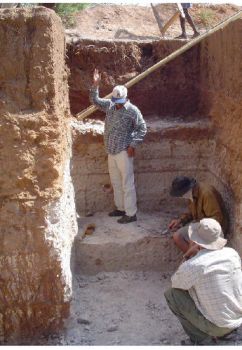Evidence
found in excavations by international team of scientists at Jwalapuram
in Kurnool district of Andhra Pradesh

— Photo: Ravi Korisettar
Ravi Korisettar and Michael Petraglia (in the foreground) at one
of the excavation sites.
THIRUVANANTHAPURAM: In the course of archaeological excavations
at Jwalapuram in Kurnool district of Andhra Pradesh, an international
team of scientists has found evidence that anatomically modern
humans are likely to have reached India before a massive volcanic
eruption in what is today Indonesia occurred tens of thousands
of years ago.
“Super-eruption”
The “super-eruption” of the Toba volcano in Sumatra
some 74,000 years ago was the largest volcanic event to have occurred
in the last two million years and the ash thrown up high into
the atmosphere by that cataclysmic explosion reached India too,
said Ravi Korisettar of the Department of History and Archaeology
at Karnatak University in Dharwad, Karnataka.
During five years of excavations at Jwalapuram, Indian, British,
and Australians scientists unearthed fine stone flakes that had
been turned into tools for various purposes.
The stone tools were to be found in layers of earth above as
well as below the fine ash from the Toba super-eruption, the scientists
noted in a paper published in the latest issue of the journal
Science.
“Volcanic winter”
It had been thought that the vast amounts of volcanic ash flung
into the atmosphere by the eruption could have blocked sunlight
and produced a “volcanic winter” that decimated the
humans living then. But the evidence from the Jwalapuram excavations,
however, suggests that the volcanic eruption did not have such
a catastrophic impact on the early human population there.
Stone tools
The stone tools also pointed to a more exciting possibility.
The stone tool assemblages found in Jwalapuram were “very
similar to ones that we see produced in Africa at the same time,”
said Michael Petraglia of the Leverhulme Centre for Human Evolutionary
Studies at the University of Cambridge in the U.K, the first author
of the paper.
Those stone tools in Africa had been produced by modern humans.
“Closer affinities”
In the Science paper, the researchers noted that the techniques
used for making the stone tools at Jwalapuram suggested “closer
affinities” to African Middle Stone Ages traditions than
to contemporaneous Eurasian ones. T his finding is significant
because genetic studies of tell-tale patterns in the DNA of people
living in various parts of the world have supported the view that
all modern humans arose in Africa.
It is believed that these modern humans then migrated out of
Africa and settled all across the globe.
“So what we are saying is that modern humans probably dispersed
from Africa into India at a very early date, earlier than anyone
has suggested before,” Dr. Petraglia told this correspomndent.
There is a hypothesis that modern humans could have taken the
“southern route of dispersal,” utilising the coastlines
to travel from Africa, through Arabia, across the Indian subcontinent
and then into South-East Asia and finally into Australia, he said.
The presence of modern humans in India at the time of the Toba
super-eruption would be consistent with humans having used the
southern route, but would remain speculative till further excavations
were carried out in the Indian subcontinent and Arabian peninsula,
remarked the scientists in their journal paper.
Key role
India has a played a key role in the migration of modern humans
out of Africa, says K. Thangaraj of the Centre for Cellular and
Molecular Biology at Hyderabad. In a paper published in Science
two years ago, Dr. Thangaraj and others held that genetic lineages
to be found among Andaman islanders supported an out-of-Africa
migration by modern humans some 50,0000 to 70,000 years ago.
Archaeological data
Dr. Korisettar is, however, sceptical about modern humans opting
for a coastal route for their migration. [Sic: One is curious
about the archaeological data for such a very early migration.
We cannot use Mehrgarh obviously, which is only about 7000 BC
at the earliest. I will try to find out. NSR]
There was currently no archaeological evidence of such ancient
human migrations along India’s west coast and into southern
Tamil Nadu. Rather, the available archaeological data favoured
a continental route whereby early humans came through the Bolan
and Khyber passes to the north-western parts of the Indian subcontinent
and then into Rajasthan before dispersing to other parts of the
country, he added.
© Copyright 2000 - 2008 The Hindu.